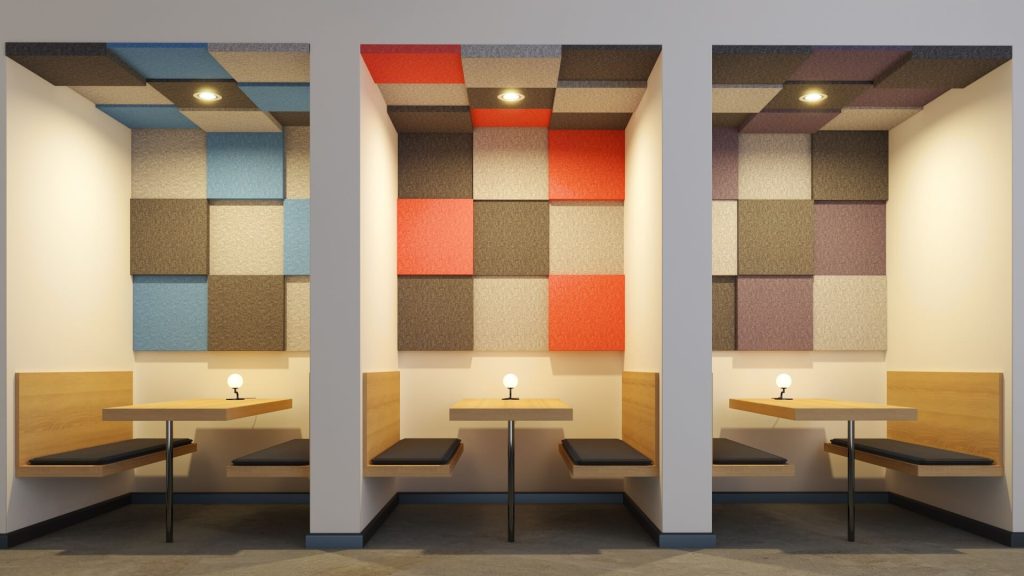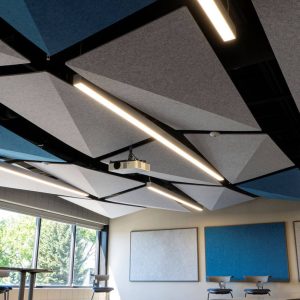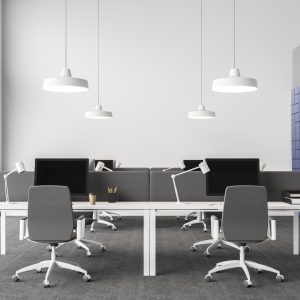Found at the intersection of mindful living and acoustical performance, PET felt delivers the results we’re after without creating the waste we don’t. That’s because this versatile material offers amazing sound absorption and it’s made from recycled products. If you’re in the market for great sounding spaces made from eco friendly materials, choosing acoustical products made from PET felt material will tick both boxes. Today we’re going to take a look at what PET felt material is, how we use it to improve acoustics, and some of the creative ways this unique solution can deliver stunning visuals that tie your interior design together.
What is PET Felt Material?
PET plastic, or Polyethylene Terephthalate plastic, is a synthetic material that is used in a wide range of products across the spectrum of consumer goods. One of the most common uses includes beverage bottles and other single use plastic products, but its highly recyclable nature means we can extend its usefulness long after we have consumed our beverages or unboxed our new toys. Reconstructing single use products into new ones delivers big benefits for the environment, and some of the products we create with this repurposed plastic far surpass the performance of similar materials. This is just the case with PET felt. PET felt is made with a mixture of recycled and virgin PET plastic fibers, and it makes a fantastic sound absorber for recording studios, healthcare facilities, universities, and office environments.
How is PET Felt Made?
Similar to traditional felt, PET felt is made of pressed material that are interlocked to produce a soft appearance. The great advantage we get with PET felt is that instead of using wool or some other fiber that is resource intensive to obtain, PET felt is made of those melted and reconstituted plastic bottles that would otherwise end up in the landfill. The recycled plastic bottles are compressed, shredded, and melted down to produce PET felt. This process creates soft fibers that are next pressed together to form the sheets of PET felt we use in acoustical wall panels and other acoustical products. There are some wonderful benefits that accompany choosing this production route.
Benefits of Using PET Felt
We have used traditional felt for thousands of years, so what makes PET felt so appealing in modern applications? When it comes to acoustically treating spaces, choosing to use a PET felt material in place of some of the other popular acoustical materials on the market delivers a number of impressive benefits.
Superior Sound Absorption
Acoustic panels aren’t incredibly useful if they don’t provide the sound absorption that will effectively reduce the occurrence of acoustical issues. PET felt offers superior sound absorption, on par with some of the most effective traditional acoustic materials on the market. This means you can achieve awesome acoustical performance while reducing your carbon footprint at the same time.
PET Felt is Manufactured with Recycled Products
PET felt material is made largely from recycled plastic, meaning it utilizes fewer resources and less energy in its production. Any time we can use repurposed products, it is not only helpful for local environments and the planet at large, but it also means that these readily available base materials may come at a slightly lower cost than some other options.
Versatility
The versatility of PET felt material means it can be formed into all kinds of acoustical materials, including wall and ceiling tiles, baffle systems, and a range of other wall coverings and ceiling systems. No matter what kind of solutions you’re after and what kind of space you’re working with, there are PET products that will easily meet and exceed your expectations.
PET Felt Material is Easy to Install
PET felt is extremely easy to install, since it can be cut to size on site. Melt the edges to finish after cutting, and you’ve got a custom cut piece of attractive fabric, no matter what size format you’re working with. Prefabricated solutions are even easier to install. You just need a basic understanding of what you’re after and possess a few basic installation skills and tools.
It’s a Low VOC Emissions Material
PET felt is a low VOC material, meaning it contains low amounts of Volatile Organic Compounds (VOC), compared to other materials. Low VOC materials can safely be used in all building applications without negatively affecting indoor air quality, and their use may qualify your organization for many different green building certifications, including LEED , LBC , WELL, and more.
It’s Resistant to Moisture and Bacterial Growth
The same plastic composition that makes PET felt hypoallergenic and easy to clean also makes it uniquely adapted to withstanding moisture and the growth of mold and bacteria. If you are treating spaces like gymnasiums, yoga studios or dance studios, this incredible benefit speaks for itself.
PET Felt is Available in Amazing Colors
Dyed plastic has the ability to deliver much more vibrant colors than dyed fabric. That means we can get brighter pops of color and increased definition with PET panels when compared with other acoustical fabrics. Depending on where you are placing your panels, this vibrancy can make the difference between a nice looking space and something that’s truly eye-popping.
What Makes PET Felt so Effective in Acoustical Treatments?
Standard felt isn’t something most people associate with acoustical treatments. Felt made of wool or other natural fibers isn’t the most absorptive material on the planet, so why use PET felt to control noise? Does PET felt absorb sound? The answer is in the construction. PET felt material is acoustically porous, which means it allows sound waves to permeate the surface. When sound waves enter PET felt, it interacts with the fibers and air gaps inside, slowing its progression and turning its vibrational sound energy into heat energy. The process of converting vibrational energy into heat energy is known as sound damping, and is the key to effective sound absorption. If you require more sound absorption than your PET felt provides, utilizing an air gap behind the material will improve its performance and provide greater sound control. Some products are built with this air gap in mind. In order to find out if that’s the case, you’ll first need to decide which application works best for your situation.
Applications for PET Felt
From commercial design to modern residential construction, PET felt can deliver effective noise control that provides an enhanced sense of serenity and contributes to more productive work environments. Creating stunning visuals is easy as well, due to the wide range of applications for PET felt material. Let’s take a look at some of the most popular applications for PET felt in the world of acoustical treatments.
PET Acoustic Panels
One of the most common and versatile acoustical treatment products on the market is the acoustic panel. These panels can be mounted directly onto walls and ceilings, and can even be suspended into open air to absorb and damp sound waves. They effectively reduce echo and reverberation, and can even double as art pieces. Utilizing PET felt material in place of fiberglass and acoustically transparent fabric in panels delivers a hypoallergenic build and washability that makes them ideal for spaces where kids or animals come together, or where high humidity presents problems with mold growth.
PET Baffles
Another common use of PET plastic in acoustical treatments is in ceiling baffles. Baffles are horizontal panels or planks that are typically pre assembled into panels and suspended from the ceiling, creating parallel lines and increased acoustical performance for open ceiling designs. They allow air and light to flow through, maintaining the look of open or industrial ceilings, but their absorptive nature helps keep unwanted noise at bay. PET felt baffles are a wonderful choice when you want to maintain a view of the true ceiling or mechanical, electrical, and plumbing (MEP) systems. Lighting can even be suspended between baffles, allowing you to deliver light sources exactly where you want or need them. This is a very popular choice in restaurants, lobbies, and other gathering spots.
PET Ceiling Clouds
PET ceiling clouds deliver both acoustic and aesthetic benefits in one simple package. They work to absorb sound waves in the same way that acoustic panels do, but are suspended from the ceiling into the room to provide a couple of key benefits. First, PET ceiling clouds help reduce echo and reverberation by catching sound waves as they pass through the open space over our heads. This allows them to catch both the initial waves that move vertically from the source and the reflected waves that bounce off our walls, ceilings and floors. They even quiet the mechanical, electrical, and plumbing (MEP) systems overhead. Second, they make our ceilings look amazing. PET felt ceiling clouds are available in all the same vibrant colors as wall-mounted acoustic panels, and can be custom printed as well. This means you can achieve whatever look you’re after to create eye-catching focal points that leave everyone talking about your attention to detail.
Sourcing the Right PET Materials for Your Project
Acoustically treating spaces with PET felt materials that provide the results you’re after requires research, as well as a knowledgeable partner that knows how to procure the right products. That combination will ensure your vision and acoustics work in the space you’re treating. If you would like to learn more about our range of offerings or how to turn your designs into reality, reach out for a consultation.



